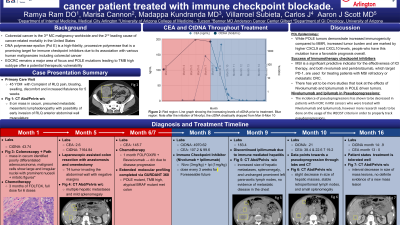Monday Poster Session
Category: Colon
P1742 - ctDNA Response in a POLE-mutation Associated Colon Cancer Patient Treated With Immune Checkpoint Blockade
Monday, October 23, 2023
10:30 AM - 4:15 PM PT
Location: Exhibit Hall

- RR
Ramya Ramachandran, DO
HCA-Medical City Arlington
Arlington, Texas
Presenting Author(s)
Ramya Ramachandran, DO1, Marisa E. Cannon, BS2, Madappa Kundranda, BS, MD, PhD3, Aaron J. Scott, BS, MD4
1HCA-Medical City Arlington, Arlington, TX; 2University of Arizona College of Medicine-Tuscon, Tucson, AZ; 3Banner Health, Gilbert, AZ; 4University of Arizona Cancer Center, Tucson, AZ
Introduction: Colorectal cancer is the third most common malignancy worldwide and the second-leading cause of cancer-related mortality in the United States. The incidence of early onset colorectal cancer (EOCRC) has been increasing over the past several decades. While the etiologies for this increase remain unclear, genetic factors likely play an important role. In the largest dataset for molecular analyses by Lieu et al (2019) and Lander et al (2023), DNA polymerase epsilon (POLE) mutations occur at a much higher rate than average onset colorectal cancer (AOCRC). DNA polymerase epsilon (Pol ε) is a high-fidelity, processive polymerase that is a promising target for immune checkpoint inhibitors due to its association with various human malignancies including colorectal cancer. EOCRC remains a major area of focus and POLE mutations leading to TMB high subtype offer a potential therapeutic vulnerability.
Case Description/Methods: We present a case report of a patient with POLE mutant, metastatic EOCRC who exhibited rapid progression despite standard chemotherapy followed by a dramatic response in ctDNA and radiographic imaging to immune checkpoint inhibition. This patient is an otherwise healthy 45 year old man originally diagnosed with pT4N2Mx stage IIIC cecal adenocarcinoma 5/9/2022. The patient underwent 6 cycles of neoadjuvant FOLFOX followed by a laparoscopic assisted right colon resection with re-anastomosis on 9/8/2022. Surgical margins were negative, however, post-operative restaging imaging showed numerous diffuse liver metastases. His CEA peaked at 145.7 and Signatera® circulating tumor (ct)DNA testing measured 7164.8 MTM/ml. Extended molecular profiling via Tempus® revealed several genetic aberrations: tumor mutation burden (TMB) high, POLE mutation, PIK3CA mutation, and an atypical BRAF mutation. The patient then received 3 cycles of FOLFOXIRI, however, CT imaging revealed rapid progression of his liver metastases. After 3 doses of immune checkpoint blockade, his ctDNA dropped to 0.21 MTM/ml and after 6 doses his CEA has dropped to 1.4 ng/ml with ctDNA 0.00. Radiographic imaging has demonstrated marked regression of his liver metastases and remains on treatment.
Discussion: Here we describe a 45 yo patient with POLE mutated metastatic colon cancer who experienced a dramatic and durable complete ctDNA response to immune checkpoint inhibition after progression on standard chemotherapy. This case report supports further clinical evaluation of immune checkpoint blockade in this patient population.
Disclosures:
Ramya Ramachandran, DO1, Marisa E. Cannon, BS2, Madappa Kundranda, BS, MD, PhD3, Aaron J. Scott, BS, MD4. P1742 - ctDNA Response in a POLE-mutation Associated Colon Cancer Patient Treated With Immune Checkpoint Blockade, ACG 2023 Annual Scientific Meeting Abstracts. Vancouver, BC, Canada: American College of Gastroenterology.
1HCA-Medical City Arlington, Arlington, TX; 2University of Arizona College of Medicine-Tuscon, Tucson, AZ; 3Banner Health, Gilbert, AZ; 4University of Arizona Cancer Center, Tucson, AZ
Introduction: Colorectal cancer is the third most common malignancy worldwide and the second-leading cause of cancer-related mortality in the United States. The incidence of early onset colorectal cancer (EOCRC) has been increasing over the past several decades. While the etiologies for this increase remain unclear, genetic factors likely play an important role. In the largest dataset for molecular analyses by Lieu et al (2019) and Lander et al (2023), DNA polymerase epsilon (POLE) mutations occur at a much higher rate than average onset colorectal cancer (AOCRC). DNA polymerase epsilon (Pol ε) is a high-fidelity, processive polymerase that is a promising target for immune checkpoint inhibitors due to its association with various human malignancies including colorectal cancer. EOCRC remains a major area of focus and POLE mutations leading to TMB high subtype offer a potential therapeutic vulnerability.
Case Description/Methods: We present a case report of a patient with POLE mutant, metastatic EOCRC who exhibited rapid progression despite standard chemotherapy followed by a dramatic response in ctDNA and radiographic imaging to immune checkpoint inhibition. This patient is an otherwise healthy 45 year old man originally diagnosed with pT4N2Mx stage IIIC cecal adenocarcinoma 5/9/2022. The patient underwent 6 cycles of neoadjuvant FOLFOX followed by a laparoscopic assisted right colon resection with re-anastomosis on 9/8/2022. Surgical margins were negative, however, post-operative restaging imaging showed numerous diffuse liver metastases. His CEA peaked at 145.7 and Signatera® circulating tumor (ct)DNA testing measured 7164.8 MTM/ml. Extended molecular profiling via Tempus® revealed several genetic aberrations: tumor mutation burden (TMB) high, POLE mutation, PIK3CA mutation, and an atypical BRAF mutation. The patient then received 3 cycles of FOLFOXIRI, however, CT imaging revealed rapid progression of his liver metastases. After 3 doses of immune checkpoint blockade, his ctDNA dropped to 0.21 MTM/ml and after 6 doses his CEA has dropped to 1.4 ng/ml with ctDNA 0.00. Radiographic imaging has demonstrated marked regression of his liver metastases and remains on treatment.
Discussion: Here we describe a 45 yo patient with POLE mutated metastatic colon cancer who experienced a dramatic and durable complete ctDNA response to immune checkpoint inhibition after progression on standard chemotherapy. This case report supports further clinical evaluation of immune checkpoint blockade in this patient population.
Disclosures:
Ramya Ramachandran indicated no relevant financial relationships.
Marisa Cannon indicated no relevant financial relationships.
Madappa Kundranda indicated no relevant financial relationships.
Aaron Scott indicated no relevant financial relationships.
Ramya Ramachandran, DO1, Marisa E. Cannon, BS2, Madappa Kundranda, BS, MD, PhD3, Aaron J. Scott, BS, MD4. P1742 - ctDNA Response in a POLE-mutation Associated Colon Cancer Patient Treated With Immune Checkpoint Blockade, ACG 2023 Annual Scientific Meeting Abstracts. Vancouver, BC, Canada: American College of Gastroenterology.
